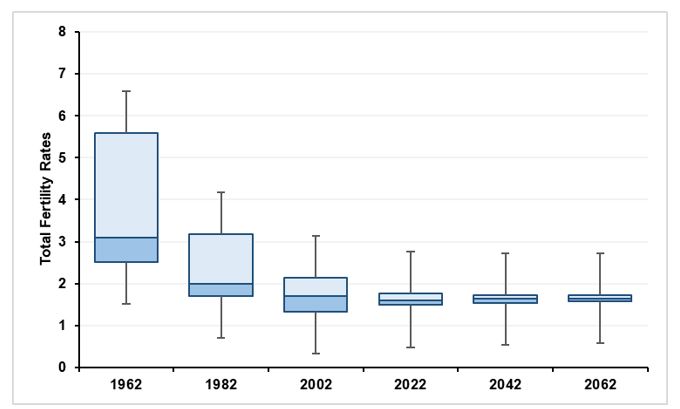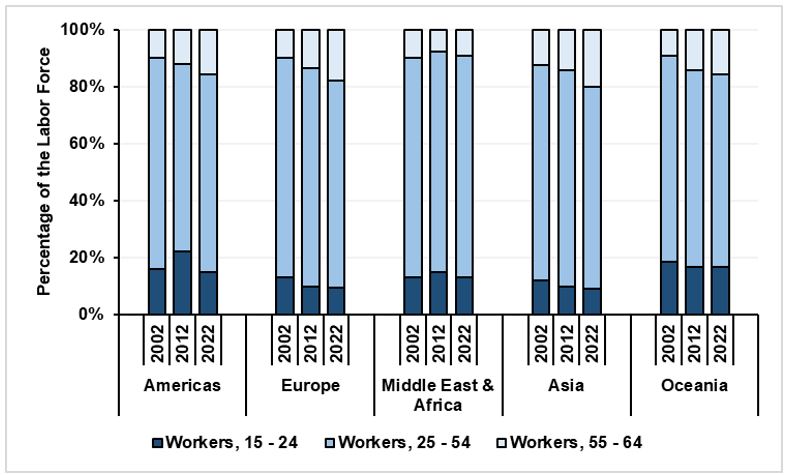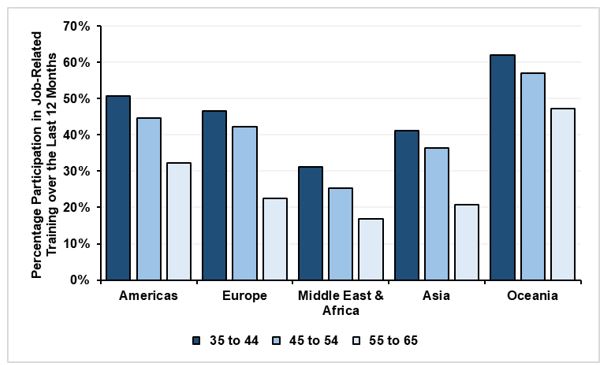Global labor markets must contend with numerous challenges today such as nascent skill deficits, extreme fluctuations in the business cycle, and automation by intelligent technologies. Yet, these issues are all eclipsed in magnitude and precedence by an aging workforce, generally defined as an increase in the share of working, retirement-eligible employees.1 An aging workforce is indicative of a healthy society sustained by increased life expectancy, but it also carries significant risks without adequate preparation for the resulting shift in labor demographics, or investment to accommodate this growing segment of the economy. These risks include reduced labor force participation, decreased productivity, excess capacity, increased fiscal imbalances, as well as lower economic growth.2
Despite these risks, an aging workforce also provides new opportunities for global labor markets when supported by prudent economic policy. Employment enables elderly workers to maintain financial security, with positive outcomes for physical, cognitive, and emotional health. An aging workforce also preserves critical human capital for firms, allowing them to remain productive, while exploring new avenues for innovation.3 Finally, an aging workforce drives economic growth by underpinning the "silver economy", an ecosystem of goods and services designed to satisfy the preferences of elderly individuals.4 These opportunities can be realized when economic policy encourages global labor markets to commence preparations for the demographic and economic shifts from an aging workforce.
This essay will examine aging within global labor markets from the perspective of policymakers seeking to minimize its risks and maximize its opportunities. We will first explore the drivers behind an aging labor market as well as the risks of inaction. Next, we offer policy recommendations which enable global labor markets to capitalize on the opportunities from this phenomenon. This essay will assist developed and developing economies alike by addressing a preeminent issue within global labor markets today.
An Aging Workforce
An aging global workforce is the direct consequence of an aging population. By 2050, the number of people aged 50 and older is expected to expand nearly 70 percent from 1.9 billion to 3.2 billion.5 This expansion will reach its zenith in the next decade, with 2.3 billion people reaching at least 50 years of age by 2030.6 Between 2020 to 2050, the share of people aged 50 and older is projected to rise from 24 percent to 33 percent, more than double the growth rate of this population from 1970 to 2020.7 These datapoints reflect two seismic, concurrent, demographic trends: 1) an increase in life expectancy, which is expected to average 80 years of age by 2050, as well as 2) a decrease in fertility, which has fallen by more than 50 percent since the 1970s as shown in Figure 1 below.
With fewer young entrants to the labor force, employers have become increasingly dependent on the institutional knowledge and experience of older workers to maintain productivity. Older workers have increased capacity to oblige given innovations in healthcare which have bolstered their life expectancy, as well as the changing nature of work which has shifted in favor of less strenuous physical activity and more flexibility.10 Conversely, some older workers have been forced to stay in the workforce given deterioration in their financial security driven by the Great Recession and COVID-19 pandemic, as well as an evolution in retirement policies which reward additional time in the labor force and do not focus on defined benefits, such as 401(k) plans.11 These factors have enabled the acceleration of an aging labor force. As per Figure 2 below, the number of older workers per every 100 employees is expected to double over the next 60 years.
Figure a: Historical and Projected Median Global Old-Age to Working-Age Ratio (source: OECD, author's calculations)
Risks from an Aging Workforce
Risks from an aging workforce arise from neglect and obstinacy toward the challenges associated with this phenomenon. Inadequate accommodation may push older workers out of the formal labor force, eroding productivity while raising excess capacity as firms produce less output than their potential. Lower labor force participation can also aggravate fiscal imbalances as national authorities cannot raise enough capital to care for their inactive population, which can also reduce economic growth.12 A recent study by the American Staffing Association identified several likely key push factors that discouraged participation for older generations in the US labor market. When asked, older adults were more likely to agree that they are hesitant to search for a new position due to their age, that their age puts them at a disadvantage when searching for a new position, and that their age limits their career opportunities.13 As the proportion of older to prime age workers grows the world over, these the sentiments of older generations regarding ageism should be taken all the more seriously to ensure they are not neglected by society and that they become active participants in the labor market.
These risks can be mitigated through action on the emergent challenges to older workers. One prominent challenge is age discrimination, generally defined as the differential treatment of older workers through hiring, firing, promotion, and layoff decisions, in addition to inferior assignments, benefits, and training opportunities. As per Figure 3 below, age discrimination increases in prevalence as life expectancy increases.14 This issue is particularly salient within many upper-middle income and lower-middle income countries with weak discrimination laws.15 Academic research has consistently determined age discrimination undermines the ability of older workers to transition between jobs or even reenter the workforce, while costing billions,162 if not trillions, in lost economic output every year. 16
Figure 3: Relationship between Life Expectancy and Age Discrimination (source: Officer et. al., author's calculations)
Another significant challenge is the global pensions timebomb, defined as a growing imbalance between public retirement obligations, and the allocated finances to fund them. As per Figure 4 below, the shortfall in pension finances, or retirement savings gap, in eight of the largest global economies estimated to host half of all workers over 50 years old is expected to total $400 trillion by 2050.18 Lower fertility and rising life expectancies are not the only drivers of this emerging crisis. Nearly 50 percent of the retirement-age population does not receive a pension, while average contributions are significantly lower than the 10 to 15 percent target.19 Furthermore, pension assets have had to navigate increased volatility within global financial markets, while the popularity of defined contribution plans has foisted significant responsibility for their management onto lay individuals despite low levels of financial literacy worldwide.20 In addition, popular anxiety during periods of inflation – whether real or perceived – could threaten workers' willingness to save. Considering how older adults in the U.S. are statistically more likely to self-report that their paycheck is inadequately keeping up with inflation; those who would be typically closer to retirement age feel that perhaps a dollar saved does not go as far as it once did, lowering incentives to save for the demographic who most need to. Altogether these factors complicate the ability for global pensions to maintain their long-term sustainability.21
Figure 4: Global Retirement Savings Gap (source: WEF)
A third challenge is ensuring the productive utilization of increased life expectancy among workers through improved health outcomes. This requires delaying the onset of both physical and cognitive disabilities, as well as improving functional capacities as they deteriorate with age.22 In addition to expanding systemic capacity to address issues facing the current workforce, it would also necessitate a fundamental shift in strategy that focuses on prevention rather than treatment, thereby targeting younger generations to intercept potential health risks before they worsen.23 These recommendations are echoed throughout much of the academic research examining deficiencies in the response of global healthcare systems to COVID-19, a crisis that acutely affected the health and finances of older workers.24
Opportunities for Economic Policy
Aging within global labor markets is a process which has manifested over decades. As shown by Figure 5 below, older workers have steadily constituted a larger share of the workforce in most regional labor markets since 2002. In Europe and Asia, regions which host some of the largest global economies, older workers currently comprise almost 20 percent of the total workforce. Prudent economic policy can assist countries with adapting to these trends and capitalizing on their benefits.
Figure 5: Composition of Regional Workforces by Age (source: OECD, author's calculations)
First, countries must vigorously discourage age discrimination within private labor markets, which can be achieved through economic incentives as well as financial penalties. For example, the "Corporate Value People" program in Germany subsidizes up to 80 percent consultancy costs for small and medium-sized enterprises seeking services to develop age-inclusive management practices.25 Conversely, the Age Discrimination in Employment Act (ADEA) in the United States has been amended on several occasions to expand potential offenses and increase damages awarded to successful plaintiffs.26 Although financial penalties have exhibited more efficacy in reducing age discrimination, they also carry an increased risk of negative externalities as firms alter their behavior to meet legal requirements but retain the same biases intended to be ameliorated.27 International cooperation is also essential to preserve gains from action by individual countries. Equality Directive 2000 instituted by the European Union, enabled over 20 member nations to embed protections for older workers in existing national labor laws,28 and serves as a template for recent efforts by the United Nations to develop a global policy framework against age discrimination. 29
Next, countries must reconfigure their pension systems in a manner that ensures their long-term adequacy and sustainability. Direct reforms usually consist of reducing the generosity of benefits through modifying calculation formulas such as the inflation indexation component, amending valorization rules which govern adjustments to past earnings, and elongating the rate at which pension benefits accrue.30 Indirect reforms usually include containing the total amount of eligible recipients by changing parameters of the pension system, such as Brazil's decision to raise the retirement age for men and women from 56 and 53 to 65 and 62 respectively,31 as well as creating public options that compete against private, more expensive alternatives, such as Sweden's implementation of AP7, a low-cost fund offered by the Swedish premium pension system.32 These reforms may not be applicable to countries such as China and South Korea, where private savings rates are high while social security systems offer low coverage as well as generosity.33 In such cases, a sedulous expansion of eligibility and benefits afforded through their pension systems could channel private saving proclivities toward reducing inequality and old-age poverty.34
Third, countries must employ a whole-health approach towards national healthcare. This includes further research into age-specific drivers of disease and disability, as well as preventative medicine which focuses on nurturing healthy habits within younger generations. The latter would encompass promotion of proper dieting and physical activity, which could be incentivized through public education initiatives as well as financial subsidies.35 These efforts could be tailored by socioeconomic characteristics that would allow efforts to focus on the most at-risk populations including individuals with preexisting conditions and those living at or below the poverty line.36 Older workers should also receive specialized patient education that focuses on preserving their health status and minimizing complications, which would enable them to limit unnecessary interactions with the healthcare system.37 A whole-health approach to healthcare must also focus on reducing environmental comorbidities such as excessive pollution, poor sanitation, in addition to food and water insecurity through optimized urban planning.38 Such efforts would supplement patient care by improving physical welfare and reducing preventable public health expenditures.
Additionally, countries should increase investment within upskilling and reskilling opportunities for older workers. These programs allow firms to preserve human capital, which is important for sustaining workforce productivity as well as economic growth, and especially relevant given a steady shift within the global economy towards knowledge-intensive services. They can also assist older workers with retaining their cognitive abilities, which have been shown to decline with age at a similar pace as physical strength and overall health.39 As shown by Figure 6 below, older workers are less likely to participate in job-related training, suggesting significant room for improvement. Subsidizing firm-sponsored training is an inefficient solution because they foster deadweight loss and substitution effects which benefit firms but not always older workers.40 In lieu of direct financial incentives, dissemination of information regarding skill gaps facing older workers as well as the benefits of upskilling and reskilling programs from national authorities could sufficiently inspire innovation within private markets. This would allow individual firms to develop programs that are unique to their industry, workforce, and long-term needs.41
Figure 6: Participation in Job-Related Training over the Last 12 Months by Age Group (source: OECD, author's calculations)
Finally, countries should harness the potential of their silver economy, generally understood to be economic activity supporting products and services which meet the needs of older individuals. As shown by Figure 7 below, consumers over 50 years of age already account for the majority of spending in half of all major product and service categories.42 Alongside their capacity as consumers, older individuals often have greater income, fewer commitments, as well as more experience, making them ideal entrepreneurs or financiers for new products or services inside and outside the silver economy.43 Countries and firms should encourage older individuals to employ these skillsets via flexible employment arrangements that allow them to remain as active contributors to the economy at-large. Furthermore, since older individuals are more dependent upon maintaining a sense of community through connection with peers, investments within technology as well as social engagement platforms will be critical for developing the silver economy via support for their mental and cognitive health. Countries should also be prepared for the associated learning curves which will likely arise as older individuals take time to adapt to such technological advancements.
Figure 7: Share of Consumption by Older Consumers (source: AARP, Economic Intelligence Unit)
Conclusion
Aging within global labor markets will become a preeminent challenge for multiple generations of employees, employers, consumers, and policymakers. An aging labor market is not the consequence of a healthy society but a natural response to its excellence which requires the same innovation and adaptation which first engendered such achievement. The risks of inaction are matched only by the opportunities from action – where failure to address budding challenges from an aging workforce can diminish productivity and economic growth, while incremental adjustments can support them. These efforts will require collaboration between private markets, national authorities, and international organizations given the sheer complexity of the issues facing older workers and the magnitude of their implications for society.
In this essay, we reviewed several economic policies which could encourage global labor markets to commence preparations for the demographic and economic shifts from an aging workforce, including regulations that reduce age discrimination, reforms to national pension systems, a whole-health approach to national healthcare, increased investment within upskilling and reskilling programs, as well as realizing the full potential of the silver economy. If enacted, these policies could enable the international economy at-large to realize over $118 trillion in economic growth, including $53 trillion in labor income supported by 1.5 billion jobs.44 Most importantly, adapting to an aging workforce would preserve a healthy economy for generations to come, marking another milestone in humanity's storied history of adaptation and progress.
About the Authors
Noah Yosif serves as Chief Economist at the American Staffing Association (ASA). In this capacity, he is responsible for leading research initiatives which support the American staffing industry and highlight its unique niche within the broader economy. Noah is also a member of the Economic Affairs Committee of the World Employment Confederation (WEC), which coordinates international research efforts on issues within global labor markets. He holds an MPA from the University of Pennsylvania and an MA in Applied Economics as well as a BA in Economics from the George Washington University.
Max Aldrich serves as Research Coordinator at the American Staffing Association (ASA). In this capacity, he conducts research on trends within the staffing industry, and its impact on the broader economy. He holds dual Bachelor's degrees in Economics and Business as well as History from Cornell College.
Footnotes
Download footnotes here.








